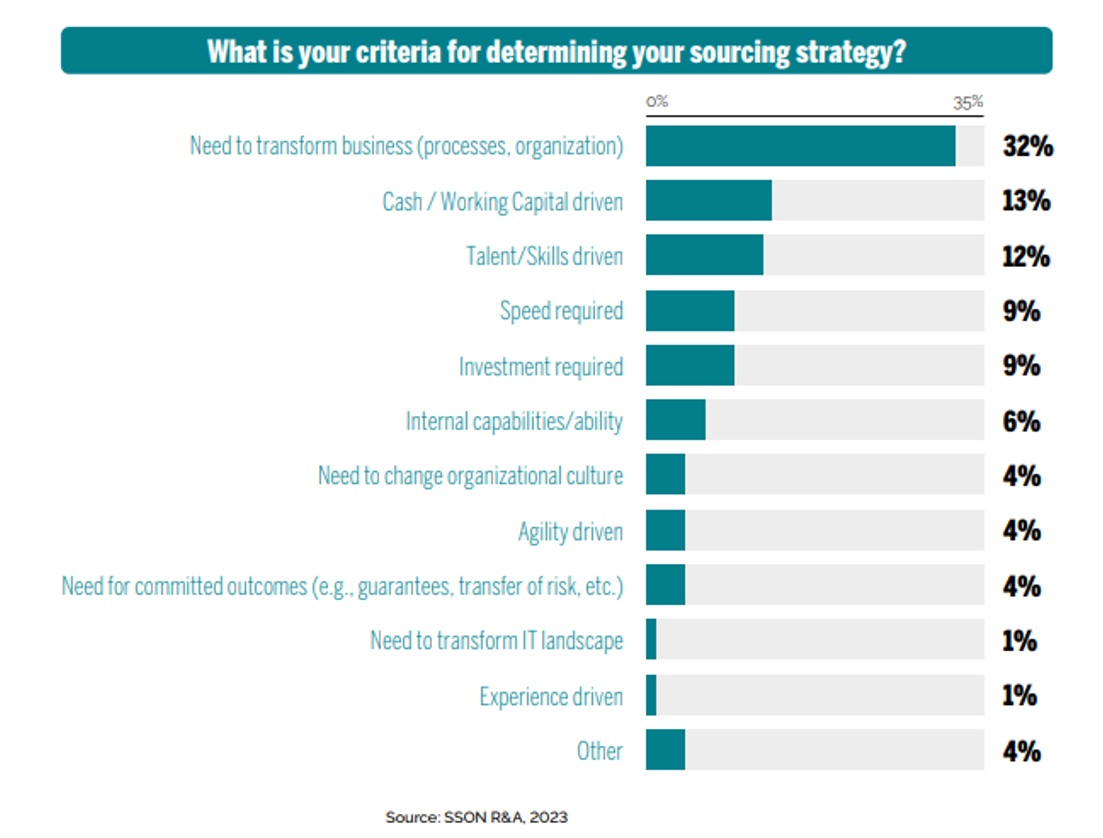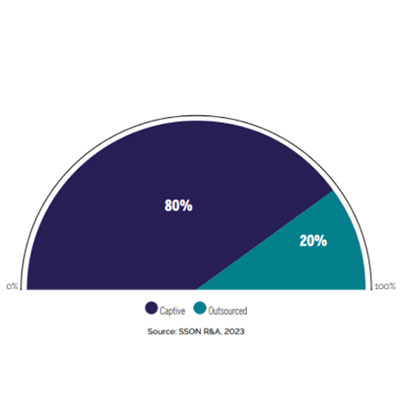PROCESS EDGE
INVITING APPLICATIONS
14th SSF EXCELLENCE AWARDS & RECOGNITION – 2025
LAST DATE: JUL-25 | APPLY NOW
Highlights
- What are the pros and cons of outsourcing work versus establishing your own offshore center?
- One common mistake organizations make is assuming their processes are well-structured and standardized, only to discover the contrary upon closer examination.
- Another critical factor to consider is the maturity of the in-house systems and applications.
- Talent plays a vital role, regardless of whether the organization opts for an outsourcing partner or an offshoring (GCC) model.
IN THIS ARTICLE
What a Dichotomy!
Balancing offshoring and outsourcing
Manoj Madassery

The Outsourcing & Offshoring Industry in India has witnessed remarkable growth over the past two decades, and this trend is expected to continue in the coming years. The country’s highly skilled workforce, favourable business environment, and competitive cost structure have made it a hub for IT and business process outsourcing. Presently, this industry employs over 4 million professionals, and it is projected to create another 2 million jobs by 2025. Interestingly, a significant portion of this workforce, around 20%, operates within Global Capability Centers (GCCs).

A recent SSON report highlights that ‘despite the capability and large size of GBS/SSO centers around the world (45% employ more than 1000 FTEs), requirements for specific skills as well as technologies are one of the key drivers behind the continued commitment to outsourcing. Half of the GBS/SSO surveyed include outsourcing in their operating model, often working with more than one BPO.
Recently, outsourcing trends have become a popular choice not only across finance and IT services, but also, in areas like master data management, supply chain and customer services. Even though the business services practitioners believe that the benefits of an offshore captive centre outweigh those of an outsourced engagement, their reliance on outsourcing partners has grown exponentially. Some of the significant identified reasons behind this trend are the increase in scope beyond traditional Finance and HR and thus requirement for support; capabilities – skilled resources and expertise; and technology.

SSON’s report also brings to light the choice of the organizations very clearly to captive or offshoring. In response to their survey question – “In comparing captive (offshoring) and outsourcing operation, which of the two sourcing approaches has delivered more benefit to you in total?”
This raises an important question: What factors contribute to this 80:20 split between traditional outsourcing and GCC/GBS or captive models? What are the pros and cons of outsourcing work versus establishing your own offshore center? This article, aims to shed light on the decision-making process behind these choices, emphasizing the key factors that contribute to their long-term success.
Before embarking on the journey of deciding whether to opt for offshoring or outsourcing, it is crucial to address three fundamental questions that will serve as guidelines for any organization’s decision-making process.
1. How standardized and mature are your processes?

One common mistake organizations make is assuming their processes are well-structured and standardized, only to discover the contrary upon closer examination. For example, in a Finance RTR transformation case, initially, it was assured that all processes resided in SAP, which will ensure a seamless transition. However, upon further investigation, a lack of standardization became evident with multiple instances of SAP. As a response, promptly a centralized team was established to focus on standardizing processes before engaging in an outsourcing partnership. Put it simply, it is recommended to adopt a similar approach—begin with offshoring or create a capability center to standardize your processes first. Failing to do so may result in additional time and financial investments with your outsourcing partners.
2. How mature are your systems and applications?

Another critical factor to consider is the maturity of the in-house systems and applications. For instance, a few years ago, there was a situation where a particular project involved a business that relied on a legacy system. To ensure improved efficiency and continuity, a decision was made to outsource this aspect to a partner. However, despite investing substantial time and finances over a span of two years, the desired objectives were not achieved. It became apparent that there is no long-term plan in place for this application, thereby resulting in ultimately bringing the project back in-house. It is crucial to note that engaging an outsourcing partner can offer a competitive advantage, only when your organization possesses a clear long-term vision & maturity for the systems and applications.
3. How crucial is talent in your industry or process?

Talent plays a vital role, regardless of whether the organization opts for an outsourcing partner or an offshoring (GCC) model. In an outsourcing setup, talent specializes in specific processes or technologies, while in a GCC, talent thrives as industry specialists.
According to a market analysis report by Grand View Research, it is estimated that there will be approximately 600,000 bots running in the Finance and Insurance industry by 2028. The advancements witnessed in the Finance and Insurance sectors can be attributed to the presence of a skilled talent pool with expertise in processes and technologies within the outsourcing partner ecosystem. Their contributions have been invaluable during various crucial stages, including implementations, significant process changes, automation, and productivity enhancements. On the other hand, in an offshoring setup, the focus is on industry-specific expertise, such as in manufacturing processes.
It is crucial to recognize the importance of both horizontal and vertical talents, Process expertise and Industry expertise, as they complement each other and contribute to a successful outcome. Consider the nature of your organization and determine the talent requirements that align with your goals. If an organization requires long-term access to talent critical for the success of its core technology, then offshoring can be a significant avenue for acquiring and nurturing that talent. If the organization's current objective is to drive innovation, reduce costs, and leverage process expertise based on a set of standardized processes you already possess, then partnering with an outsourcing provider could be the appropriate choice.
In Summary
The decision between offshoring and outsourcing is a critical one that requires careful consideration of process standardization, system maturity, and talent needs. The industry has witnessed the evolution and impact of both – offshoring and outsourcing. By prioritizing these factors and aligning them with organizational goals, businesses can harness the benefits of offshoring or outsourcing, ultimately driving their success in an ever-evolving global landscape of business operations.
Sources
- (https://www.grandviewresearch.com/industry-analysis/robotic-process-automation-rpa-market)
- https://theprint.in/theprint-valuead-initiative/indias-ites-bpo-industry-expected-to-grow-at-8-per-cent-cagr-reach-us225-250-bn-by-2025/796827/
- The State of Global Business Services in 2023 And Beyond – SSON RESEARCH & ANALYTICS Report
ABOUT THE AUTHOR

Manoj Madassery
Manoj Madassery is an executive with a background in Engineering and Finance , and with over 30 years of experience in leading Service Delivery Teams and Global Capability Centres. He has a strong background in building teams, developing people & culture and building organizations from scratch. He has successfully established and grown the KBS India center, a Technology & Business Services GCC for Koch industries and have led various roles in finance, supply chain service delivery at IBM Global Services. In the 3 decades of experience, he has managed large-scale projects, implemented talent strategies, and led teams on new technologies like Watson Analytics, Blockchain and RPA.



 Ask an Expert
Ask an Expert




